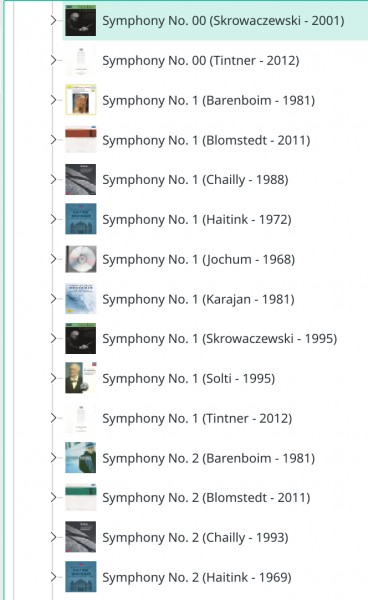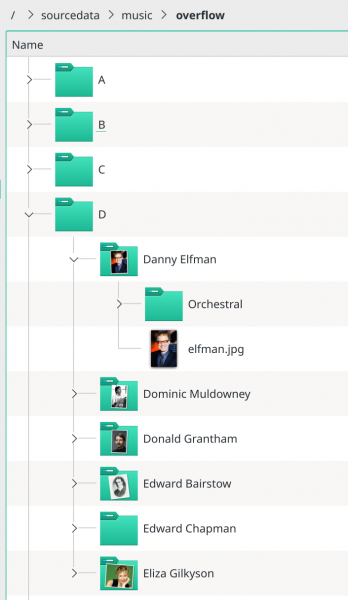 Once you've been collecting music for a while, you will suffer from an abundance of riches: those 15 different versions of the Beethoven symphonies; those 5 complete sets of Bach cantatas; at some point, they will all become difficult to navigate and make playing any particular recording increasingly difficult.
Once you've been collecting music for a while, you will suffer from an abundance of riches: those 15 different versions of the Beethoven symphonies; those 5 complete sets of Bach cantatas; at some point, they will all become difficult to navigate and make playing any particular recording increasingly difficult.
It is for such times that an 'overflow' library is a good idea: a separate physical storage area on disk where you move your lesser-played recordings to as you come to realise that they aren't your favourite performances any more. They're still there on disk, though: so they can be restored from the overflow folder back into the main library if you change your mind later on! Or (more pertinently), they can be played at will whether they are considered 'overflow' or not.
You can see a little bit of the problem in this screenshot from my Strawberry media player's main library:
That's 9 different versions of Bruckner's 1st symphony... and that doesn't include another three versions I've just recently acquired! In and of itself, having lots of Symphony No. 1s isn't a problem: it's easy enough to pick one and play, after all. What's more of a problem is that almost an entire screens'-worth of vertical real estate is given over to displaying just a single composition, albeit in many different performances. That makes scrolling through to Symphony No. 8 harder and longer than it should -and, accordingly, the temptation grows to just select symphonies off the top of the list. It's quicker that way!
Well, you can see here how I physically organise my main music library:
There's a 'root' folder, called /sourcedata/music/classical. Within that, there are 'alphabet' folders, one for each letter of the alphabet. Within any one of those, 'composer folders' are created, one per composer (catalogued by their first name, so Bruckner is found under the 'As', not the 'Bs'!). Within any composer folder, separate 'genre folders' are created, depending on what sort of output the composer engaged in (so Britten will have a 'Radio' folder and Bach won't!) And finally, within any genre folder, each composition gets its own folder, named with an 'extended album name' of composition name - distinguishing artist - recording year.
To deal with an over-stuffed main library, therefore, I simply replicate this entire structure under an 'overflow' folder:
You can see at the top of this screen capture that I'm still in my /sourcedata/music folder, but now I'm in the /overflow sub-folder, not the /classical one, as I was before. That's important, because I still want everything to be within the one music folder: I backup "music" as a whole, not just some of it, so by keeping the overflow folder within the same music parent folder as my main 'classical' folder , I get to treat the entire music collection as one entity for backup purposes, even though it's now divided between two sub-folders.
Within this new overflow folder, though, everything works as before: 'alphabet folders', 'composer folders', 'genre folders' and, finally, compositions. With the overflow having the exact same logical structure as the main library, it's trivial to cut-and-paste folders out of one and into the other (or vice versa!)
The key thing is that this means I get to keep all my music. Personally, I no longer find Danny Elfman someone I listen to very often, so I don't want him cluttering up my main music collection... but I still think he's worth listening to sometimes, so I don't want to 'demote' his music in any way or make it harder to listen to. By bumping it out of /music and into /overflow, I clear him out of my main music player's library -but he's still there, easily accessible, backed up, integrity-checked and in every way as 'valid' a recording as any other I own.
If I apply this to my Bruckner symphony collection, I end up with this arrangement:
The plethora of symphony cycles I've acquired over 30 years have mostly been moved into the overflow area (on the left), leaving just my two favourite cycles in my main library (on the right). This makes my main library's music player's display a lot more navigable than before:
Now I can almost see every single Bruckner symphony in one screenfull -no need to scroll (except to get Symphony's 8 and 9 into view). It's a lot more navigable than before, anyway -and I think that makes choosing a symphony to play a lot easier. And when something's easier to do... you'll tend to do it more often!
But if I want to play a Karajan recording of a Bruckner symphony? Do I have to move the file back from overflow into main?
No: I keep a separate music player handy for that, which only catalogues the overflow area. So, for my main music player (Strawberry), the settings options look like this:
That is, it's been pointed at the /classical folder (i.e., my "main" library folder). So Strawberry only displays the main catalogue recordings.
Meanwhile, I've configured the Clementine player (a close cousin of the Strawberry player, in fact) like so:
And so we see that Clementine is only allowed to catalogue the overflow folders. If I want to play my Karajan recordings of Bruckner symphonies, therefore, I simply have to play them from Clementine. (Of course, Clementine will now have the problem of a long list of different recordings of Bruckner's symphonies to scroll through... but since the aim is to not be playing things from the overflow area very frequently (if they are, they don't count as candidates for the overflow area!), this need to scroll around and do slow navigation through a lot of choices is not the big drama it was when the main library had always to be tackled that way.
As mentioned, if I do ever find I'm playing something a lot in Clementine, it's a good clue that the recording in question doesn't deserve to reside in the overflow area, but should be physically moved back into the main catalogue (easy enough to do with a cut-and-paste manoeuvre in my file manager). But in the meantime, everything in the overflow area remains as playable as anything in my main catalogue... but the main catalogue looks tidier!
I think it takes years of collecting music recordings to get to the point of having an 'overflow' area: if you've only got one or two recordings of a work, scrolling through them is never going to be an issue, after all. But give it 20 or 30 years of reckless spending and magpie-like accumulation, and you'll want to be able to split things into 'favourite' and 'less favourite' recordings very easily. Nailing down a flexible, transparent and easily-navigated physical file storage layout for your main library is key to being able to do that when needed, at some time in the future!






